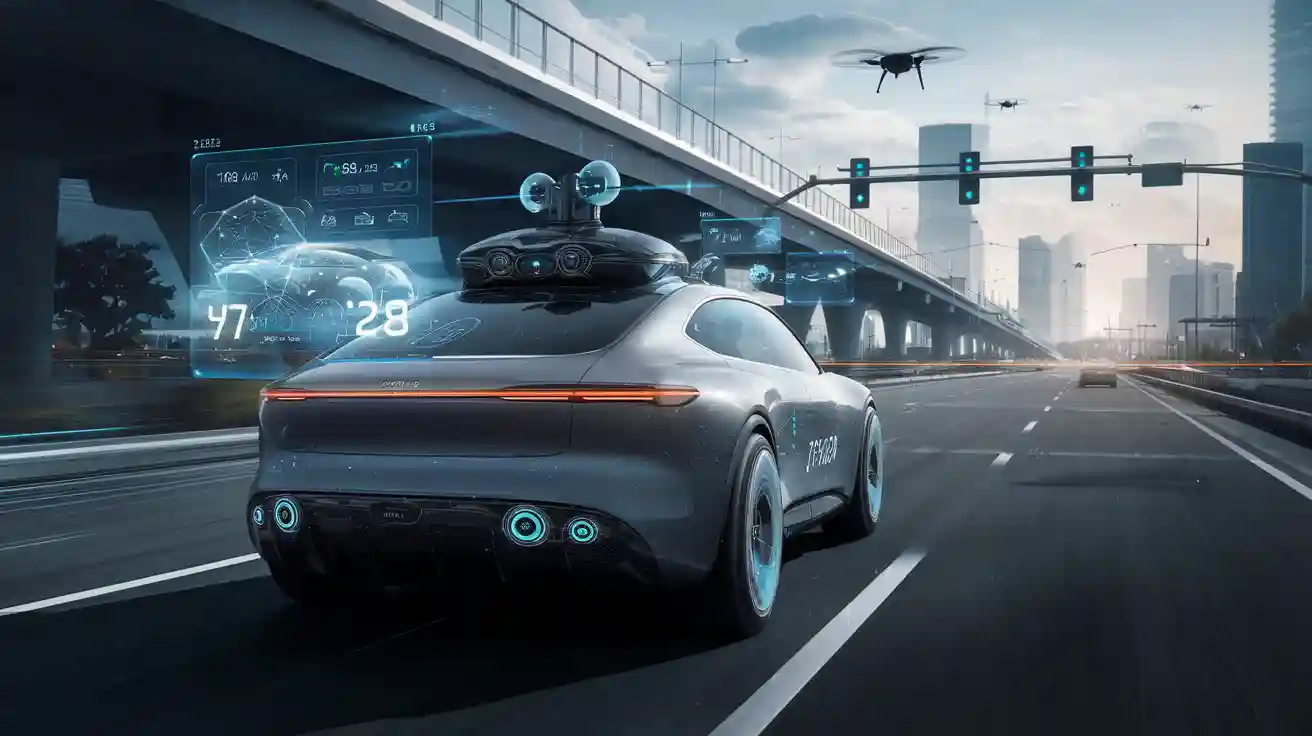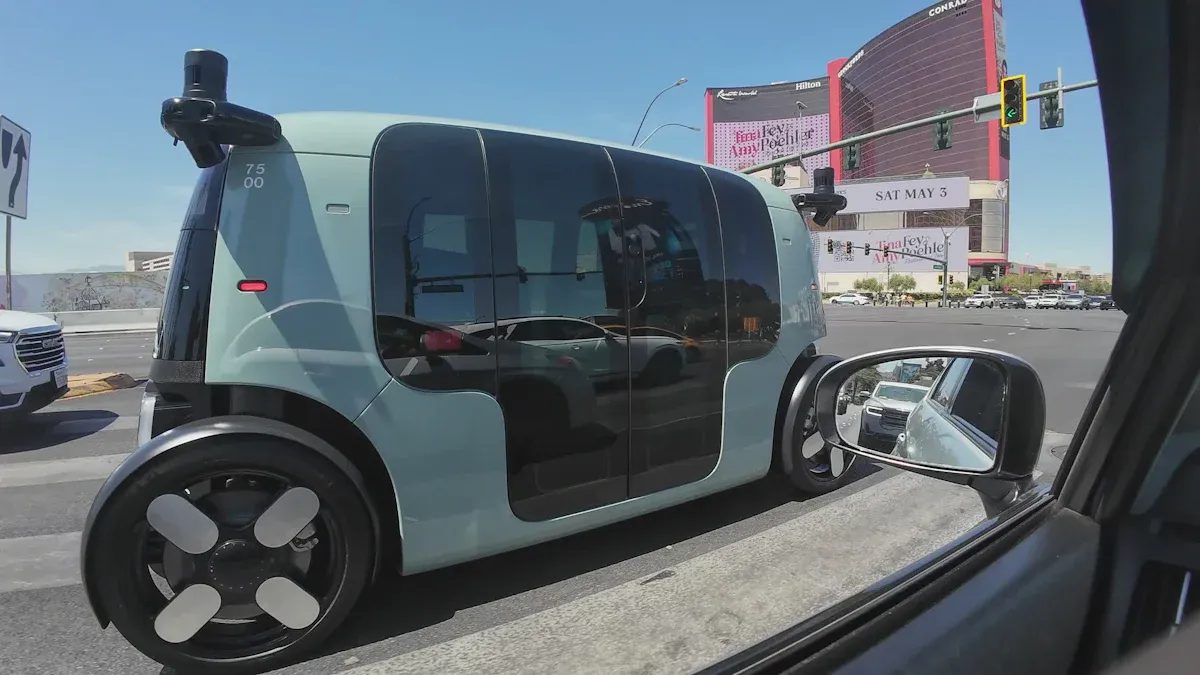
Artificial intelligence (AI) has revolutionized the way AI autonomous driving vehicles operate, acting as the driving force behind their ability to perceive and navigate the world. By enabling self-driving cars to make real-time decisions, AI transforms traditional transportation into a safer and more efficient system.
-
AI-related innovations could generate up to $215 billion in value for automotive manufacturers by 2025, according to McKinsey.
-
Proactive AI-based maintenance already reduces breakdown costs by 30% while extending vehicle component lifespan by 20%.
-
Surveys reveal that many people believe driverless vehicles can reduce global carbon emissions and prevent accidents caused by human error.
This blend of technology and autonomy has the potential to reshape urban mobility and improve safety, making AI autonomous driving a cornerstone of future transportation.
Key Takeaways
-
AI helps self-driving cars avoid crashes caused by human mistakes. This makes traveling safer for all people.
-
AI uses smart tools to fix cars before they break down. This saves money and makes driving smoother.
-
AI improves how traffic moves and cuts down on jams. This means quicker trips and better transportation for everyone.
AI as the Brain of Autonomous Vehicles

Artificial intelligence serves as the central nervous system for autonomous vehicles, enabling them to perceive their surroundings, make decisions, and navigate complex environments. Let’s explore how AI powers these critical functions.
Perception and Environmental Understanding
Perception is the foundation of autonomy in self-driving cars. AI processes data from sensors like LiDAR, radar, and cameras to help vehicles understand their surroundings. This involves several key tasks:
-
Detection: Identifying the exact location of objects such as pedestrians, other cars, and road signs.
-
Classification: Determining what each object is, whether it’s a cyclist, a stop sign, or a traffic cone.
-
Tracking: Monitoring the movement of dynamic objects like vehicles and pedestrians.
-
Segmentation: Assigning each pixel in an image to a specific category, such as road, sidewalk, or vehicle.
For example, the perception module in self-driving cars processes inputs from 128-channel LiDAR, radar, and high-resolution cameras. It outputs 3D obstacle tracks, traffic light detection results, and classification information. This allows the car to “see” and interpret its environment with remarkable accuracy.
By leveraging AI-powered algorithms, self-driving cars achieve a level of environmental understanding that surpasses human capabilities. This ensures safer and more efficient navigation, even in challenging conditions.
Real-Time Decision-Making and Problem-Solving
AI enables autonomous vehicles to make split-second decisions, a critical requirement for safe and efficient driving. Real-time data processing allows self-driving cars to navigate complex environments by instantly analyzing inputs from sensors and cameras.
Key advancements in this area include:
-
Immediate obstacle detection and pedestrian recognition, which enhance safety by preventing collisions.
-
On-the-spot route adjustments to avoid traffic jams or roadblocks.
-
Localized data processing using edge AI, which eliminates delays caused by transmitting data to a central server.
For instance, technologies like YOLO (You Only Look Once) and convolutional neural networks (CNNs) empower vehicles to recognize traffic signs and objects in real time. This capability ensures that self-driving cars can respond quickly to dynamic situations, such as a child running into the street or a sudden lane closure.
AI’s ability to process and act on data instantly transforms autonomous driving into a seamless and reliable experience.
Navigation and Path Planning
Navigation and path planning are essential for autonomous vehicles to reach their destinations efficiently and safely. AI algorithms analyze vast amounts of data to determine the best routes while adhering to traffic rules and avoiding obstacles.
Recent advancements in this field include techniques like A* and Rapidly-exploring Random Trees (RRT), which improve the initialization strategy and reward function design for path planning. Another innovative approach integrates behavior cloning models into navigation systems, allowing vehicles to mimic human driving behaviors. This results in higher path completion rates, even in unfamiliar environments.
|
Technique |
Description |
Improvement |
|---|---|---|
|
APF |
Introduces a reward function based on an artificial potential field |
Optimizes the training process of DQN |
|
A*, RRT |
Combines A* and RRT concepts into DDQN |
Enhances initialization and reward design |
AI-powered navigation systems also optimize fuel efficiency by selecting routes with minimal congestion. This not only reduces travel time but also contributes to environmental sustainability.
By combining advanced algorithms with real-world adaptability, AI ensures that autonomous vehicles can navigate safely and efficiently in any scenario.
Key Applications of AI in Self-Driving Cars
Artificial intelligence plays a pivotal role in enabling self-driving cars to operate efficiently and safely. From processing sensor data to analyzing insurance claims, AI powers the core functionalities of autonomous vehicles. Let’s explore some of its key applications.
Sensor Data Processing and Object Detection
AI processes vast amounts of data from sensors like LiDAR, radar, and cameras to help autonomous vehicles understand their surroundings. This process, known as sensor fusion, combines inputs from multiple sources to create a comprehensive view of the environment.
-
Waymo’s AI system adjusts driving behavior based on real-time traffic conditions, ensuring safe navigation.
-
Multi-task learning enhances sensor fusion, improving object detection and lane recognition. This leads to better spatial awareness, even in challenging conditions.
-
AI systems adapt to adverse weather, such as heavy rain or fog, maintaining operational safety.
For example, AI-driven object detection algorithms identify and classify objects like pedestrians, vehicles, and road signs. These systems also track moving objects and predict their trajectories, enabling self-driving cars to avoid collisions. By leveraging real-time data analysis, Waymo has reduced accidents caused by human error by up to 90%.
AI’s ability to process sensor data ensures that self-driving vehicles can navigate safely and efficiently, even in complex environments.
Traffic Sign and Pedestrian Recognition
Recognizing traffic signs and pedestrians is critical for autonomous vehicles to follow traffic rules and ensure safety. AI-powered systems use advanced object detection algorithms to identify and interpret traffic signs, even in challenging scenarios.
-
Studies show that algorithms like those developed by Cai et al. achieve high accuracy in detecting traffic signs and pedestrians in easy conditions, with performance metrics of 83.92%. However, accuracy decreases in moderate and hard conditions, highlighting the need for further advancements.
-
Ren et al.’s algorithms perform better in challenging scenarios, achieving 90.19% accuracy in the KITTI dataset’s moderate category.
AI systems also excel at detecting small or partially obscured objects, which is crucial for pedestrian safety. By improving detection accuracy, these systems enhance the overall reliability of self-driving cars.
Predictive Maintenance and Vehicle Health Monitoring
AI enables predictive maintenance by analyzing historical data to forecast potential issues before they occur. This proactive approach reduces maintenance costs, improves vehicle performance, and enhances safety.
|
Metric |
Description |
|---|---|
|
Predicting Component Failures |
AI forecasts when parts are likely to fail, allowing timely repairs. |
|
Reducing Maintenance Costs |
Efficient scheduling of maintenance lowers overall costs. |
|
Improving Vehicle Performance |
AI detects performance deviations, enabling adjustments to optimize efficiency. |
|
Enhancing Safety |
Early issue detection ensures safer operation of autonomous vehicles. |
For instance, predictive maintenance systems monitor engine performance and battery health in real time. This ensures that self-driving cars remain in optimal condition, reducing the likelihood of breakdowns and delivering a superior user experience.
Insurance and Liability Data Analysis
AI transforms the insurance landscape for autonomous vehicles by analyzing data to assess risks, prevent accidents, and streamline claims processing.
-
Predictive analytics models reduce claims related to autonomous vehicle accidents by 25%.
-
AI enables dynamic usage-based insurance models, increasing customer satisfaction by 40% through accurate risk assessments.
-
Automated claims processing powered by AI decreases fraudulent claims by 30% and significantly reduces resolution times.
By leveraging AI, insurance companies can offer tailored policies for driverless vehicles, ensuring fair pricing and efficient service. This not only benefits insurers but also builds trust among users of self-driving cars.
Benefits of AI in Autonomous Driving
Enhanced Safety and Accident Prevention
AI plays a crucial role in making self-driving cars safer by reducing accidents caused by human error. Advanced AI models analyze historical crash data, GPS, and road maps to identify high-risk areas. This helps autonomous vehicles avoid potential hazards. Systems like VuDrive even monitor driver behavior using cameras to address distracted driving. Additionally, AI-powered tools such as PREDISS predict pedestrian-vehicle conflicts at intersections, which account for 25% of traffic fatalities in the U.S. By integrating these technologies, self-driving cars can significantly enhance safety and save lives.
Traffic Optimization and Reduced Congestion
AI in self-driving cars improves traffic flow and reduces congestion in urban areas. For example, congestion pricing systems informed by AI can lower traffic volume by 15–25%. Smart parking solutions further ease congestion by up to 12%, while AI-optimized detour routing cuts commute times by as much as 20%. These advancements not only make your daily commute faster but also contribute to a more efficient transportation system.
Environmental Benefits and Fuel Efficiency
AI helps autonomous vehicles achieve better fuel efficiency, which reduces their environmental impact. Studies show that self-driving cars can decrease operational emissions by 21.2% due to improved fuel economy. However, manufacturing emissions may increase by 40%. When considering the entire life cycle, autonomous electric vehicles might emit 8% more greenhouse gases than their nonautonomous counterparts. Despite this, AI-driven path planning and environmental perception ensure that these vehicles operate more sustainably during their use phase.
Did you know? AI-optimized driving patterns not only save fuel but also reduce wear and tear on vehicle components, extending their lifespan.
Cost Savings and Operational Efficiency
AI enhances the operational efficiency of self-driving cars, leading to significant cost savings. Predictive maintenance systems powered by AI monitor vehicle health in real time, preventing costly breakdowns. AI also optimizes fuel consumption and reduces idle time, cutting operational costs. For businesses, autonomous vehicles equipped with AI can streamline logistics and delivery operations, boosting productivity and profitability.
Challenges of AI in Self-Driving Technology
Cybersecurity and Data Privacy Concerns
AI in self-driving cars relies heavily on real-time data from sensors, cameras, and cloud systems. This dependence makes autonomous vehicles vulnerable to cyberattacks. Hackers could manipulate vehicle systems, leading to safety risks or even accidents. Protecting data privacy is another challenge. Self-driving cars collect vast amounts of personal information, such as location and driving habits. Without proper safeguards, this data could be misused. You must consider how companies secure these systems to maintain trust and ensure safety.
System Reliability and Real-World Adaptability
Autonomous vehicles must perform reliably in diverse real-world conditions. Factors like weather, road quality, and unexpected obstacles can affect system performance. Metrics such as collision mitigation rates and false positive rates highlight these challenges. For example:
-
Collision mitigation rates show how well the system prevents accidents compared to human drivers.
-
False positive rates measure how often the system incorrectly identifies hazards.
-
System availability reflects the operational uptime of the vehicle.
-
User trust scores indicate how confident people feel about the system's reliability.
Improving these metrics is essential for building trust in self-driving technology.
Ethical Dilemmas in Decision-Making
AI in autonomous vehicles faces ethical challenges, especially in unavoidable collision scenarios. For instance, should a self-driving car prioritize the safety of its passengers or pedestrians? Studies like the Ethical Valence Theory (EVT) explore how AI navigates moral claims from different road users. Another method by Gerdes and Tronton balances ethical considerations with user interests. These frameworks aim to guide AI in making fair decisions, but you must recognize that no solution is perfect.
|
Evidence Description |
Key Focus |
|---|---|
|
Ethical Valence Theory (EVT) |
Navigates moral claims from road users during unavoidable collision scenarios. |
|
Decision-making method by Gerdes and Tronton |
Balances ethical considerations and user interests, especially with pedestrians. |
Regulatory and Legal Hurdles
The legal landscape for self-driving cars is still evolving. Over 80 state laws in the U.S. address autonomous vehicles, while countries like Germany and China are developing their own regulations. Agencies like the National Highway Traffic Safety Administration (NHTSA) require specific safety benchmarks for autonomous systems. These varying frameworks create challenges for manufacturers. You must navigate these regulations to ensure compliance and bring self-driving cars to market successfully.
The Future of AI in Autonomous Driving

Advancements in AI Algorithms and Hardware
AI continues to evolve, driving significant advancements in autonomous driving. Improved algorithms enhance the ability of self-driving cars to process data, predict outcomes, and make decisions. For example, Level 3 autonomous systems are rapidly advancing, offering greater autonomy and safety. Hardware innovations, such as high-performance sensors and processing units, also play a critical role.
|
Aspect |
Details |
|---|---|
|
Growth Drivers |
Consumer interest, regulatory support, and technology deployment. |
|
Hardware Dominance |
Over 75% of automotive AI revenue in 2024 comes from hardware. |
|
Software Growth |
Fastest growth expected from 2025 to 2030, focusing on performance. |
|
Market Size |
Valued at $4.8 billion in 2024, with a CAGR of 42.8% from 2025 to 2034. |
These advancements enable self-driving cars to operate more efficiently, paving the way for Levels 4 and 5 automation. As AI algorithms and hardware improve, autonomous vehicles will become safer and more reliable.
Integration with Smart City Infrastructure
The future of autonomous driving depends on its integration with smart city infrastructure. AI-powered systems will connect self-driving cars with IoT devices, cloud computing, and traffic management systems. This integration enhances decision-making and improves safety. For instance, autonomous driving could reduce traffic fatalities by up to 94%, according to the NHTSA.
|
Aspect |
Details |
|---|---|
|
Core Technology |
Autonomous driving transforms transportation. |
|
Time Savings |
Frees up 50 minutes daily for each driver. |
|
Economic Potential |
Could create a $1.5 trillion industry by 2030. |
|
Environmental Impact |
Promotes energy-efficient and eco-friendly driving. |
Smart cities will also benefit from reduced congestion and improved traffic flow. By combining AI with urban infrastructure, you can expect safer and more efficient transportation systems.
Societal Impacts and Adoption Challenges
AI in autonomous vehicles brings both opportunities and challenges. On one hand, self-driving cars promise to reduce accidents and improve mobility. On the other hand, ethical dilemmas and public perception pose significant hurdles. For example:
-
Ethical concerns include accountability and safety in unavoidable collision scenarios.
-
Public involvement and law enforcement play crucial roles in regulating autonomous vehicles.
-
Adoption depends on factors like energy consumption, urban congestion, and regulatory frameworks.
You must address these challenges to ensure the successful adoption of self-driving technology. Public trust, ethical frameworks, and robust regulations will shape the future of AI autonomous driving.
AI has revolutionized the way self-driving vehicles operate, transforming transportation into a safer, more efficient, and sustainable system. By reducing human errors, optimizing traffic flow, and cutting emissions, AI autonomous driving offers immense potential. However, addressing challenges like cybersecurity and ethical dilemmas remains crucial to fully unlock its benefits.
|
Aspect |
Evidence |
|---|---|
|
Safety |
AI systems like AEB and ACC help avoid accidents, potentially reducing 1.35 million annual deaths. |
|
Efficiency |
AI optimizes traffic flow, significantly reducing congestion. |
|
Sustainability |
AI-driven logistics can cut vehicle emissions by up to 80%. |
Note: As AI continues to evolve, your role in understanding and supporting its development will shape the future of transportation.
FAQ
What role does AI play in self-driving cars?
AI acts as the decision-making system. It processes sensor data, identifies objects, and plans routes to ensure safe and efficient driving.
How do self-driving cars handle bad weather?
AI uses advanced algorithms to adapt to conditions like rain or fog. It combines data from multiple sensors to maintain safety and accuracy.
Are self-driving cars completely safe?
No system is perfect. AI reduces human error significantly, but challenges like cybersecurity and unpredictable scenarios still require ongoing improvements.
